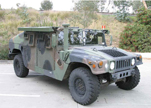
Pacific Scientific will develop a system to protect soldiers
from RPG attacks
Pacific Scientific in Hollister has received $3.5 million to
develop a system of protecting soldiers from rocket-propelled
grenade attacks.
The Department of Defense project, called
”
TRAPS
”
for Tactical RPG Airbag Protection System, combines commercial
airbags with low-cost radar technology to defend against RPG
attacks on humvees and other light military vehicles.
Pacific Scientific will develop a system to protect soldiers from RPG attacks
Pacific Scientific in Hollister has received $3.5 million to develop a system of protecting soldiers from rocket-propelled grenade attacks.
The Department of Defense project, called “TRAPS” for Tactical RPG Airbag Protection System, combines commercial airbags with low-cost radar technology to defend against RPG attacks on humvees and other light military vehicles.
The funding was secured by Congressman Sam Farr (D-Monterey), who was a member of the military construction appropriations committee that wrote the legislation. The $3.5 million project is part of $30 million Farr negotiated for local priorities, including $16.5 million for the Naval Postgraduate School in Monterey.
“Our soldiers overseas and their families at home are making incredible sacrifices,” Farr said. “Ensuring that our troops’ vehicles are protected from daily attacks is the least we can do.”
The acquired funds and those previously invested by the Army will advance testing and deployment of the current version of TRAPS.
“The $3.5 million will bridge the preceding Defense Advanced Research Projects Agency and the future program,” a spokesman for Congressman Farr said.
Pacific Scientific would not divulge details of how TRAPS will work. However, from the information gathered from the developers and Farr, a rough outline of its operation was provided.
In theory, a radar device attached to the vehicle would recognize and locate an incoming RPG. Once located, the radar triggers airbags on the exterior of the vehicle. The inflated bags would then render the projectile ineffective. How this happens, exactly, and what the crew ought to do next remains unclear.
“We are currently in the first generation of development,” said Pacific Scientific business development manager Robert Valenti. “That means we are developing the technology that would protect light vehicles. Second generation would involve heavier vehicles and would be able to sustain multiple RPG attacks.”
“TRAPS is the only protection system under development that is both affordable and avoids collateral damage,” Farr said.
According to Department of Defense guidelines, the cost of TRAPS should not be more than 20 percent of the initial cost of the vehicle it is to protect.
“We are below that mark,” Valenti said.
Despite the cost savings, “up armoring,” or adding steel plates to the sides of vehicles, will not work.
“Up armoring can only withstand small arms fire,” Valenti said. “The amount of steel needed to protect a humvee from an RPG [add so much weight it] would blow the tires. TRAPS is lightweight and can defeat incoming damage.”
Since 1948, Pacific Scientific has worked in tangent with various government agencies focused on aerospace and engineering projects – including NASA and the military. They helped design pilot ejection systems for military aircraft, and is working with NASA on the Space Shuttle as well as future space vehicles.
“Whatever it is, we are in the business of building things for the protection of somebody,” Valenti said.









